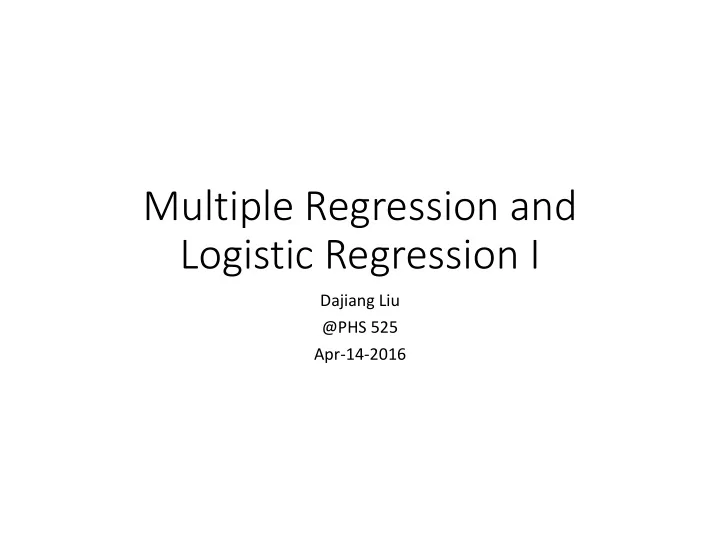

Multiple Regression and Logistic Regression I Dajiang Liu @PHS 525 Apr-14-2016
Multiple Regression • Extends simple linear regression to the scenario where • Multiple predictors are available • Multiple regression often results in better models of the outcome, as • Very few outcomes are determined by one predictor • Typically, the outcome is jointly determined multiple predictors. • Example: • Video game auction: • What factors may predict the auction price for the video games: • Mario_cart dataset
Mario_Kart Dataset
Simple Linear Regression Revisited • Examine relationships between price and cond_new ����� = � � + � × ���� ��� + � • What is the estimated values for � • Is it significantly different from 0? • Can you make a plot of the data?
Regression line
Multiple Regression • In many cases, the price can be determined by multiple predictors • In order to achieve a better model for the price, we may want to include multiple predictors in the same model • In the Mario_Kart data, we may consider a model like ����� = � + � � × ���� ��� + � � �����. ����� + � � × ���� ��� + � ! × "#��$% + �
0 0 Estimating Parameters • The parameters are estimated so that the sum of squared residuals are minimized, i.e. + � = ∑ ( � - � . )� − � - � . )� … ��& = ∑ ( ) − ( ) − � , − � , ) ) ) 1 - � . )� + � - � . )� + ⋯ is the predicted outcome based upon where ( ) = � , + � the predictors. • The model parameters are estimated such that the observed outcome and predicted outcome “agree” the best. • Can you please estimate the parameters for the Mario_Kart Example?
Why is the Estimate Different from Simple Linear Regression? • How to interpret the estimates from multiple linear regression?
Why is the Estimate Different from Simple Linear Regression? • How to interpret the estimates from multiple linear regression? Answer: Holding everything else constant, a new game cost 10.90 USD more than an old game.
How to Measure How well the Model Fit: R 2 2 2 2 Adjusted Adjusted Adjusted Adjusted R R R • Estimate the amount of variability that can be explained by the model 3 � = 1 − 5�� � ) Residual variance; the smaller the better The bigger the better 5�� ( ) • 3 � is biased • Adjusted 3 � : 5�� � ) 9 − � − 1 � 3 678 = 1 − 5�� ( ) 9 − 1 • K is the number of predictors • N is the number of sample individuals � is always smaller than the 3 � (why??) • 3 678
How to calculate 3 � from R? summary(lm(formula = totalPr ~ as.numeric(cond), data = data)) Residuals: Min 1Q Median 3Q Max -18.168 -7.771 -3.148 1.857 279.362 Coefficients: Estimate Std. Error t value Pr(>|t|) (Intercept) 60.393 7.219 8.366 5.24e-14 *** as.numeric(cond) -6.623 4.343 -1.525 0.13 --- Signif. codes: 0 ‘***’ 0.001 ‘**’ 0.01 ‘*’ 0.05 ‘.’ 0.1 ‘ ’ 1 Residual standard error: 25.57 on 141 degrees of freedom Multiple R-squared: 0.01622, Adjusted R-squared: 0.009244 F-statistic: 2.325 on 1 and 141 DF, p-value: 0.1296
y.new=data$totalPr[data$cond=='new'] y.used=data$totalPr[data$cond=='used'] y.new y.used t.test(y.new,y.used) history() names(data) data$duration data$wheels data$stockPhoto lm(totalPr~duration+stockPhoto+wheels+cond) lm(totalPr~duration+stockPhoto+wheels+cond,data=data) summary(lm(totalPr~duration+stockPhoto+wheels+cond,data=data)) history() dir() res=read.table('babies.csv',header=T,sep=','); baby=read.table('babies.csv',header=T,sep=','); names(baby) history() baby$case names(baby) lm(btw ~ gestation + parity + age + height + weight + smoke, data=baby) lm(bwt ~ gestation + parity + age + height + weight + smoke, data=baby) summary(lm(bwt ~ gestation + parity + age + height + weight + smoke, data=baby)) history
Two P-values • P-values for model fitting • � � : � � = ⋯ = � ; = 0 • � = : � � ≠ 0 or � � ≠ 0 or … � ; ≠ 0 • P-values for testing the statistical significance for each predictor • � � : � 8 = 0 • � = : � 8 ≠ 0
An Warmup Exercise
Questions of Interest • Not all predictors are useful • Including “not useful” predictors in the model will reduce the accuracy of predictors • Full model is the model that contains all predictors • Question: Determine useful predictors from the full model
Approach I • Fit the full model that contains the full set of predictors • Determine which predictors are important by looking at • P-values for testing � � : � 8 = 0 • Predictor ? is important if p-values are significant for testing � �
Recommend
More recommend